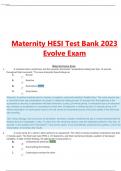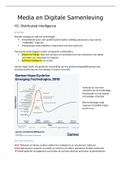Maternity HESI Test Bank 2023 Evolve Exam Maternity Evolve Exam 1. A nonstress test is performed, and the physician documents “accelerations lasting less than 15 seconds throughout fetal movement.” The nurse interprets these findings as: A. Normal B. Reactive C. Nonreactive Correct D. Inconclusive 2. A nurse caring for a client in labor performs an assessment. The client is having consistent contractions less than 2 minutes apart. The fetal heart rate (FHR) is 170 beats/min, and fetal monitoring indicates a pattern of decreased variability. In light of these findings, the appropriate nursing action is: A. Contacting the physician Correct B. Documenting the findings C. Continuing to monitor the client Rationale: A reactive nonstress test is a normal, or negative, result and indicates a healthy fetus. The result requires two or more fetal heart rate accelerations of at least 15 beats/min lasting at least 15 seconds from the beginning of the acceleration to the end, in association with fetal movement, during a 20minute period. A nonreactive test is an abnormal test, showing no accelerations or accelerations of less than 15 beats/min or las ting less than 15 seconds during a 40 minute observation. An inconclusive result is one that cannot be interpreted because of the poor quality of the fetal heart rate recording. TestTaking Strategy: Use the process of elimination. Eliminate a reactive nonstress test and a normal nonstress test first because they are comparable or alike. To select from the remaining options, note the relationship between “less than 15 seconds” in the question and “nonreactive” in the correct option. If you had difficulty answering this question, review the interpretation of nonstress test results. D. Reassuring the client and her partner that labor is progressing normally 3. A stillborn infant was delivered a few hours ago. After the birth, the family remains together, holding and touching the baby. Which statement by the nurse is appropriate? A. “I know how you feel.” B. “This must be hard for you.” Correct C. “Now you have an angel in heaven.” Rationale: Signs of potential complications of labor include contractions consistently lasting 90 seconds or longer, contractions consistently occurring 2 minutes or less apart, fetal bradycardia, tachycardia, persistently decreased variability, or an irregular FHR. The normal FHR is 110 to 160 beats/min. Therefore, because the finding is abnormal, the physician must be contacted. Continuing to monitor the client delays necessary intervention. Reassuring the client that labor is progressing normally is incorrect. The nurse would document the data, actions taken, and the client’s response, but, of the options provided, contacting the physician is the most appropriate. TestTaking Strategy: Use the process of elimination and focus on the data in the question. Eliminate the options that are comparable or alike and indicate that the data in the question are normal findings. Review normal assessment findings during the labor process if you had difficulty with this question. Rationale: Late decelerations are a result of uteroplacental insufficiency stemming from decreased blood flow and oxygen transfer to the fetus during uterine contractions. This causes hypoxemia; therefore oxygen is necessary, making the administration of oxygen the correct choice. Late decelerations are considered an ominous sign but do not necessarily require immediate birth of the baby. The oxytocin infusion should be discontinued when a late deceleration is noted. The oxytocin would cause further hypoxemia, because the medication stimulates contractions, leading to increased uteroplacental insufficiency. Although the finding needs to be documented, documentation is not the priority action in this situation. TestTaking Strategy: Note the strategic word “priority” in the question. Use your knowledge of the ABCs — airway, D. “You’re young. You can have other children.” 4. A rubella antibody screen is performed in a pregnant client, and the results indicate that the client is not immune to rubella. The nurse tells the client that: A. A rubella vaccine must be administered immediately B. A rubella vaccine must be administered after childbirth Correct C. She will not contract rubella if she is exposed to the disease D. She does not need to be concerned about being exposed to rubella 5. A nurse caring for a client in the active stage of labor assesses the fetal status and notes a late deceleration on the monitor strip. In light of this finding, which nursing action is the priority? A. Documenting the finding B. Preparing for immediate birth C. Administering oxygen by way of face mask Correct D. Increasing the rate of the oxytocin (Pitocin) infusion Rationale: A prenatal rubella antibody screen is performed in every pregnant woman to determine whether she is immune to rubella, which can cause serious fetal anomalies. If she is not immune, rubella vaccine is offered after childbirth to keep her from contracting rubella during subsequent pregnancies. The vaccine is a live virus, and defects might occur in the fetus if the vaccine were administered during pregnancy or if the mother were to become pregnant soon after it was administered. Administering a rubella vaccine immediately places the fetus at ris k. Telling the client that she does not need to be concerned about being exposed to rubella is incorrect, because the possibility of exposure, which could be harmful to the fetus, does exist. TestTaking Strategy: Use the process of elimination. Eliminate first the options that are comparable or alike (i.e., the client will not acquire rubella and does not need to be concerned about exposure). To select from the remaining options, recall that rubella vaccine is a live virus; this will direct you to the correct option. Review rubella vaccine and its implications during pregnancy if you had difficulty with this question. Rationale: Therapeutic communication helps the mother, father, and other family members express their feelings and emotions. “This must be hard for you” is a caring and empathetic response, focused on feelings and encouraging communication. The other options are nontherapeutic and may devalue the family members' feelings. TestTaking Strategy: Use your knowledge of therapeutic communication techniques. The correct option is the only option that is focused on the family members’ feelings. Review therapeutic communication techniques if you had difficulty with this question. Rationale: Strict bed rest throughout the remainder of the pregnancy is not required. The woman is advised to curtail sexual activities until bleeding has ceased and for 2 weeks after the last evidence of bleeding, as recommended by the physician or nursemidwife. The woman is instructed to count the perineal pads she uses each day and to note the quantity and color of blood on each pad. The woman should also watch for the evidence of the passage of tissue. TestTaking Strategy: Use the process of elimination. Note the strategic words “need for further instruction” in the question, which indicate a negative event query and the need to select the incorrect client statement. Noting the words “stay in bed for the rest of my pregnancy” will direct you to this option. Review therapeutic management for threatened abortion if you had difficulty with this question. Rationale: Postpartum exercises may be started soon after birth, although the woman should be encouraged to begin with simple exercises and gradually progress to more strenuous ones. Abdominal exercises are postponed until approximately 4 weeks after a cesarean birth. Kegel exercises (alternated contraction and relaxation of the muscles of the perineal area) are extremely important in strengthening the muscle tone of the perineal area after vagi nal birth. Kegel exercises help restore the muscle tone that is often lost as pelvic tissues are stretched and torn during pregnancy and birth. Women who maintain muscle strength may benefit years later, experiencing continued urinary continence. TestTaking Strategy: Use the process of elimination. Note the relationship between the word “vaginally” in the question and “perineal area” in the correct option. Review the purpose and benefit of Kegel exercises if you had difficulty with this question. 6. A nurse provides instructions regarding postpartum exercises to a client who has delivered a newborn vaginally. The nurse tells the client that: A. The exercises should be delayed for 1 month to allow healing B. Performing such exercises in the postpartum period may result in stress urinary incontinence C. Alternating contraction and relaxation of the muscles of the perineal area should be practiced Correct D. Abdominal exercises will be started while the client is in the hospital as a means of evaluating tolerance 7. A client in the first trimester of pregnancy arrives at the clinic and reports that she has been experiencing vaginal bleeding. Threatened abortion is suspected, and the nurse provides instructions to the client regarding care. Which statement by the client indicates the need for further instruction? A. “I need to stay in bed for the rest of my pregnancy.” Correct B. “I need to avoid having sex until the bleeding has stopped.” C. “I need to watch for stuff that looks like tissue coming from my vagina.” D. “I need to count the number of perineal pads that I use each day and make a note of the amount and color of blood on each pad.” 8. A nurse is assessing the respiratory rate of a newborn. Which finding would the nurse document as normal? A. 20 breaths/min B. 25 breaths/min breathing, and circulation — to answer the question. This will direct you to the correct option, the one that addresses oxygen. Review content on late decelerations if you had difficulty with this question.





